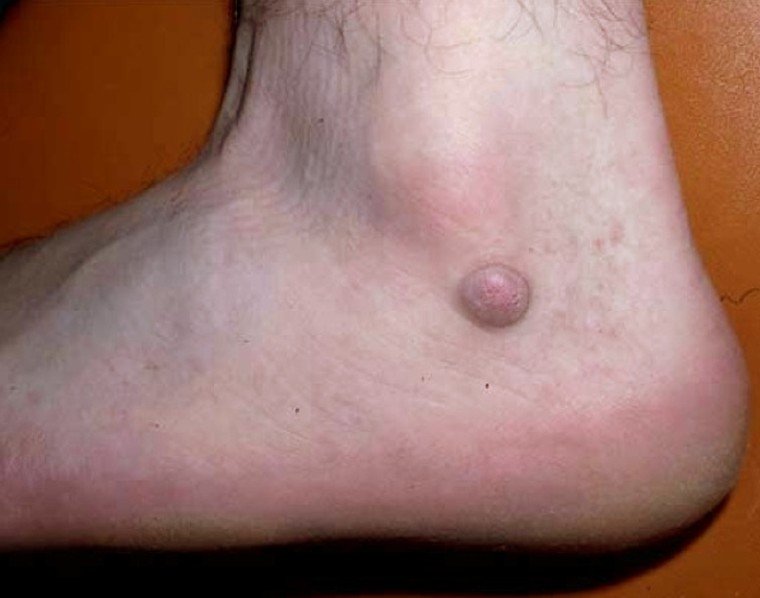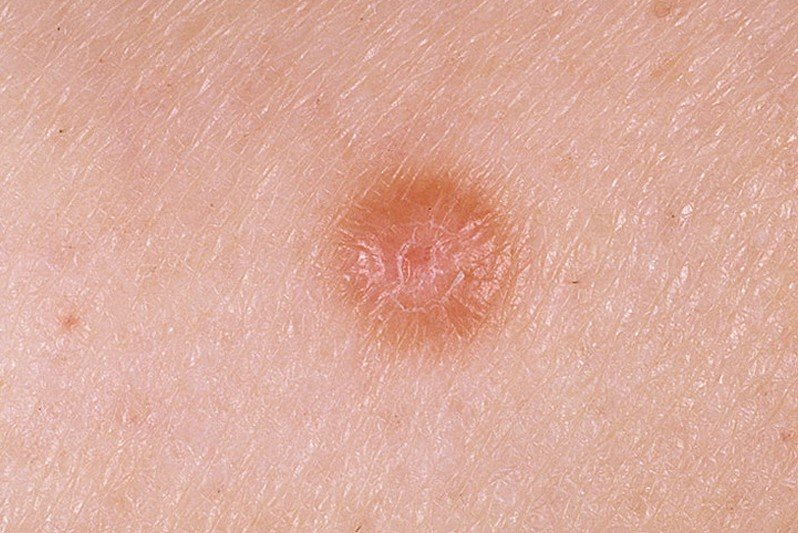Dermatofibroma
Last reviewed by Dr. Raj MD on January 12th, 2022.
What is Dermatofibroma?
This medical condition is a round knot of skin tissue that is fibrous and is usually benign, which means that it is non-cancerous. It is also called fibrous histiocytoma , histiocytoma or sclerosing hemangioma. Most of these benign knots are less than an inch in size and can range from five millimeters to ten millimeters or more. When a person develops dermatofibroma knots they usually get just one or two but there are some cases where they may appear in clusters. They can vary in colors from black, blue, red, brown, orange, pink, and yellow. Although they can appear on any part of the skin you will find them mostly on your legs or in the upper part of your body like your neck or face. It is rare to find any of these fibrous knots on your buttocks or under your arms. They can happen at any age but are most commonly found in adults, especially women. It is rare to find them on children. Dermatofibroma is a very common type of skin tumor.
Dermatofibroma Symptoms
Usually when a person has dermatofibroma they do not show any symptoms and are considered asymptomatic which means they do not have symptoms. They do have various characteristics such as:
- They are firm, small nodules, plaque, or papule.
- They may change colors over time.
- They are normally found on the lower part of your legs but can appear on the trunk of your body or your arms.
- They can be as small as a BB pellet but they very seldom grow bigger than your fingernail.
- They can be painful, itchy, or tender but are often painless.
- When they are pinched they will usually dimple inward.
- With lateral compression the skin will dimple downward.
- In people with darker skin the dermatofibroma may appear darker.
- Over time they may change color.
- It can take several months for they to develop fully.
- The surface of a dermatofibroma can be scaly, shiny, or dull.
When a person develops dermatofibroma they develop slowly. If one is nick, such as when shaving the legs, they will bleed. They will normally make their presence known when you notice a round hard mass over your skin.
Dermatofibroma Causes
It is not known exactly what causes a person to have dermatofibroma but it has been thought that some of the causes may be:
- Folliculitis, which is an inflammation of one or more of your hair follicles.
- An insect bite.
- An idiopathic benign skin tumor which is a skin tumor or medical condition that does have a known cause.
- A minor injury to the skin like an abrasion or cut.
- Cellular change where changes in the structure of the cells can make them grown and divide in a way that is different from the regular cycle of a cell making dermatofibroma growths neoplastic.
One thing that they do know is that although dermatofibroma is not hereditary it is sometimes seen in people whose family has dermatofibroma. You skin has two layers which are the dermis and epidermis. The dermatofibroma develops between these two layers as an overgrowth of fibrous tissue. This overgrowth of cells that causes is fibrous tissue takes place on the dermis, which is the inner layer of your skin.
Diagnosis
When you visit your physician they can usually diagnosis if you have a dermatofibroma by just examining the nodule. When the physician squeezes the bump it will form a dimple. If the physician wants to be sure if you have a dermatofibroma they may do a biopsy, especially if there a bleeding sore that appears on the surface of the nodule or it does not look like a dermatofibroma. When the physician orders a biopsy they will remove all or part of the nodule so it can be examined under the microscope to help the physician make the correct diagnosis.
Treatment
When a person has a dermatofibroma they will usually not need any treatment unless it begins to cause them discomfort. Because it can intervene when a person wears clothes or shaving it may make them a little uncomfortable. When shaving they need to be careful not to nick it and cause it to bleed. The fibrous knots will not heal by themselves. In addition, they cannot be permanently cured. They do not cause any type of risk to you as they are not cancerous but if a person wants they can have them surgically removed.
It is also possible to treat dermatofibroma by using external medication like cryosurgery. This form of treatment is when the dermatologist uses a liquid cooling agent and applies it to the nodule. This liquid will destroy the cell that is defective. The liquid cooling agent that is normally used is liquid nitrogen. The treatment will freeze the upper part of the growth destroying it. It makes the dermatofibroma unnoticeable but after a period of time the fibrous knot will be conspicuous again because only the upper part was destroyed, warranting another repeated treatment. This time the re-growth will be slight when you compare it to the original growth. The only drawback, or side effect, of this treatment is that it will leave a white mark behind and will leave a scar because the dermatofibroma is deep in the skin. If the dermatofibroma is not causing any discomfort it should just be left alone.
If it is itchy the physician may give you a steroid injection, which has also been known to help decrease the size of the nodule.
Home Treatments
- Use a solution of milk of magnesia for ten minutes and then rinse off.
- Increase your intake of a high-fiber, low-fat diet.
- Apply cellulite cream, which can also help to improve the appearance of the dermatofibroma.
- Avoid exposure to the sun between ten in the morning and three in the afternoon, the hottest parts of the day because the condition can be make worse by the ultraviolet rays.
- Wash the area with a mixture of cold water and two or three drops of Benzotn to help prevent infection because of the antibacterial properties in this solution.
- Although this may sting your skin you can apply spirit of camphor over the area until the skin dries up.
Removal
When a person opts to have the dermatofibroma removed surgically it will have to be excised below the surface level of your skin because of where they grow. When a person uses this method of removal there will be a scar that is noticeable which may appear more unattractive than the dermatofibroma. The scar may look more unattractive it that it is larger in shape than the nodule that was surgically removed. In addition to surgically removing it and treating it with a liquid cooling agent a person can also have it flattened to the surface of their skin by having the dermatologist or physician use a surgical knife to shave off the top of the nodule. This method of removal will not get rid of the deep layers but only the top layers so it may grow back after many years. The dermatologist may opt to use a laser treatment called carbon dioxide laser treatment which has been reported to remove the skin growth effectively.
Dermatofibroma Pictures
Collection of Pictures, Photos and Images of Dermatofibroma…






